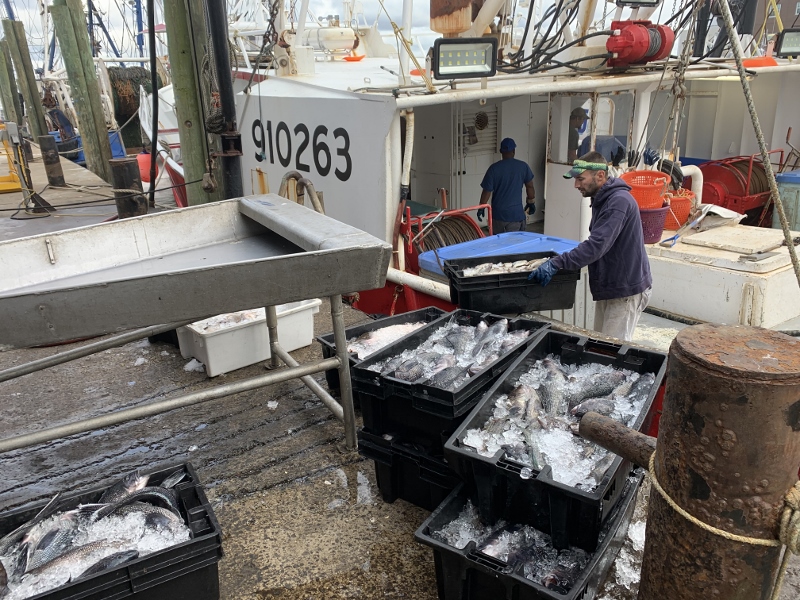Nearly six weeks after the CARES Act was signed by President Trump on March 27, funds for disaster loans, first-ever unemployment compensation for fishermen and a block of $300 million in federal direct aid began to trickle down into the industry. Fishing advocates responded with appreciation of the federal allocations as well as a warning that these funds must only be the first step to maintaining the essential services provided by the U.S. commercial fishing industry.
By mid-April the few fishermen who were able to obtain loans from the Small Business Administration Paycheck Protection Program reported meager returns, in the neighborhood of $1,000. Some reported being shut out of the program because they did not have the proper business relationships with approved federal lenders — a problem reported across a wide spectrum of industries and businesses that only exploded with reports of large corporations receiving millions in program grants.
A New York Times investigation found that public companies received nearly $1.5 billion in grant-eligible loans. However, almost a third had been returned ahead of a federal audit deadline that promised to analyze loans over $2 million to ensure that they followed strict guidelines and qualifications.
The program was originally funded at $349 billion. Another $310 billion was designated in late April specifically for small businesses.
Access to unemployment benefits was uneven and in many cases long delayed by technical stumbling blocks. Each state was required to upgrade its claims processing software and procedures to enable the new federal unemployment benefits that now included not just a new swath of independent employees (including fishermen) but also an unprecedented flood of new claims overall.
Direct aid from the Department of Commerce was disturbingly slow, according to congressional delegations from coastal states.
“It has been nearly a month since the CARES Act was signed into law by President Trump… and yet the National Oceanic and Atmospheric Administration has not released guidance for the distribution of the emergency aid nor has it publicly stated when that guidance will be released,” said Rep. Frank Pallone, D-N.J., in an April 23 letter cosigned by members from both parties.
Finally, on May 7, Commerce and NMFS officials announced state-by-state allocations had been determined. Those tranches go to NMFS partners and interstate fisheries commissions to make awards to its partners, the interstate marine fisheries commissions to disburse funds for direct or indirect fishery-related losses as well as subsistence, cultural or ceremonial impacts related to covid-19.
Alaska and Washington each received nearly double the funds of the third highest beneficiary, Massachusetts.
On the same day the allocations were announced, President Trump upstaged that news with an executive order calling for seafood industry reform, directing agencies to work together to reduce excessive regulation, streamline permitting processes for aquaculture in federal waters, and a new regime in seafood foreign trade to level the playing field for U.S. producers.
The executive order’s mention of regulation reform follows a 2018 NMFS request that the regional fishery management councils “evaluate existing regulations and make recommendations to the agency head regarding regulations to repeal, replace or modify, consistent with applicable law.”
Chris Oliver, NOAA’s assistant administrator for fisheries, said in a statement that a new Seafood Trade Task Force will “develop a comprehensive interagency seafood trade strategy. The strategy will identify opportunities to improve access to foreign markets through trade policy and negotiations; resolve technical barriers to U.S. seafood exports; and otherwise support fair market access for U.S. seafood products.”
“The creation of a Seafood Trade Task Force is an important step. The Alaska seafood industry has been trying to regain access to markets that have been very limited or unavailable to us, so we look forward to a new seafood trade strategy,” said Nicole Kimball, vice president Alaska for Pacific Seafood Processors Association.
The federal Coronavirus Food Assistance program of the U.S. Department of Agriculture expanded its Section 32 farm and food support program to buy more seafood — including historically overlooked Gulf of Mexico shrimp and Atlantic haddock, pollock and redfish for the first time, along with Alaska pollock and cod.
Fishing advocates and their supporters in Congress said the executive order and $300 million are only a down payment on needed repairs to the industry. In a bipartisan letter led by Rep. Jared Huffman (D-Calif.), lawmakers noted more than 68 percent of the $102 billion spent by consumers on U.S. seafood in 2017 came from restaurants, where covid-19 closures crippled seafood sales.
The representatives called for an additional $1.5 billion for direct relief, plus $2 billion for the USDA to purchase additional seafood. (Read the letter on page 6.)
Meanwhile, domestic seafood processors are taking an additional hit with the Department of Homeland Security’s decision not to increase the 66,000 cap on H-2B visas during the 2020 fiscal year.
The news compounded dread among Chesapeake Bay crabbers and processors, whose onshore picking house infrastructure has been dependent on migrant labor for decades.
Crab processors typically employ 400 to 500 workers on H-2B visas, said Bill Sieling, executive vice president of the Chesapeake Bay Seafood Industries Association. This year, they are getting just 150.
“Even the plants that have workers are operating at reduced capacity,” with the need for 6-foot spacing between workers and other covid-19 safeguards, said Sieling.
Meanwhile, continuing restaurant closures have slashed demand. Biologists and watermen say it looks like the bay’s crab population is robust this year. Whether watermen can make any money in a still depressed market is another matter.
Sieling says one veteran crab buyer told him: “Once the water warms up, and everything starts to move, it’s going to get really ugly for the crabbers.”







